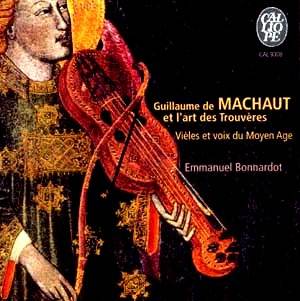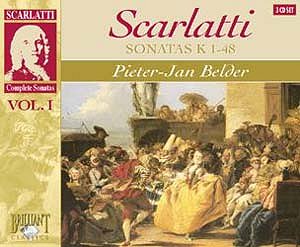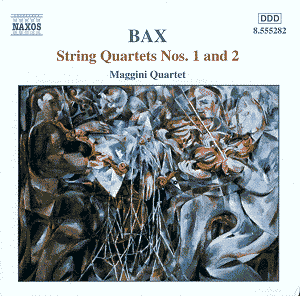 Composer: Guillaume de Machaut (ca. 1300-1377)
Composer: Guillaume de Machaut (ca. 1300-1377)
Works: et l’art des Trouvères: La quarte estampie roial, Ma vièle vièler veut un biau son, Ave Maris Stella, Cil qui d’amors me consoille, In seculum viellatoris, In seculum, En mai, La tierche estampie roial, L’autrier joer m’en alai, Tuit cil qui sunt enamourat, Apris ai qu’en chantant plour, A Virgen mui groriosa, La douce voiz du rosignol sauvage, Ne m’oubliez mie, Belle comme loiaus amans, Fi maris, Li dous regars, On demande mout souvent qu’est amours, Gracieusette, Amour trop vous doit cherir, Le lay mortel, Chanson roial
Performers: Emmanuel Bonnardot (voice, bowed strings: vielle, rebec, bowed citole, crwth), Barnabé Janin, Jean-Loup Descamps, Susanne Meyer, Valérie Ingert (bowed strings, voices, citole), Hélène Moreau (psaltery)
Recording: June 2001, Église de Sergines
Label: Calliope 9308
Guillaume de Machaut stands as a towering figure in the transition from the medieval to the Renaissance era, a composer whose polyphonic innovations reshaped the landscape of Western music. His contributions, particularly in sacred music like the famed Messe de Nostre Dame, showcase a sophistication that was revolutionary for his time. However, this recording, “et l’art des Trouvères,” presents a somewhat different perspective, focusing less on Machaut’s own compositions and more on the broader tapestry of the trouvères’ musical heritage. With only the final two tracks attributed to Machaut himself, listeners may question whether this collection aims to exploit his esteemed name to market a compilation of medieval melodies.
The selection curated by Emmanuel Bonnardot expertly traverses the rich and varied landscape of 14th-century music, encompassing both instrumental works and solo chants. The opening track, “La quarte estampie roial,” immediately transports the listener into a medieval soundscape, characterized by the droning vielles and lively rhythmic interplay. This piece serves as an admirable homage to the culture of its time, possibly echoing the influences of Arab music that permeated through Spain, and highlights Bonnardot’s keen sense of historical context and performance practice. The recording manages to embrace the diversity of the medieval repertoire, juxtaposing the robust, dance-like energy of “Cil qui d’amors me consoille” with the introspective and poignant “Ne m’oubliez mie,” where the subtlety of Bonnardot’s voice shines through a delicate instrumental backdrop.
Bonnardot’s interpretative choices are commendable, marked by a clear understanding of the emotional undercurrents in these works. His voice possesses an earthy quality that resonates with authenticity, particularly in “Le lay mortel,” which stands out as a highlight of the collection. Here, the interplay of voice and crwth creates a haunting atmosphere, revealing a tapestry of love and loss that is both timeless and immediate. The technical execution across the ensemble is notably impressive, with each instrument contributing to the overall texture without overshadowing the vocal lines. The blend of sounds maintains clarity, allowing for the intricate polyphonic structures to emerge with precision, particularly in pieces like “Fi maris,” where the three vocal lines intertwine seamlessly.
Sound quality and engineering merit mention as well; the recording captures the nuances of each instrument and voice with remarkable fidelity. The acoustics of Église de Sergines lend a natural resonance that enhances the listening experience, allowing the listener to appreciate the subtleties of the performances. Compared to other recordings that focus exclusively on Machaut’s compositions, this collection offers a broader understanding of the musical environment in which he thrived, yet it may leave purists yearning for a more concentrated selection of his works.
The assembly of music presented here, although not predominantly Machaut’s, delivers a compelling exploration of medieval sound that is both varied and engaging. Bonnardot’s thoughtful selections and interpretations succeed in creating a coherent narrative that invites listeners into a world where melodies echo the complexities of human emotion. This recording stands as an essential entry point for anyone interested in the music of the trouvères, while also illuminating the connections to Machaut’s own artistry, making it a significant addition to the catalog of early music recordings. The combination of diverse instrumentation, sensitive performance, and high-quality production ultimately makes this a noteworthy collection that resonates well beyond its historical origins.


